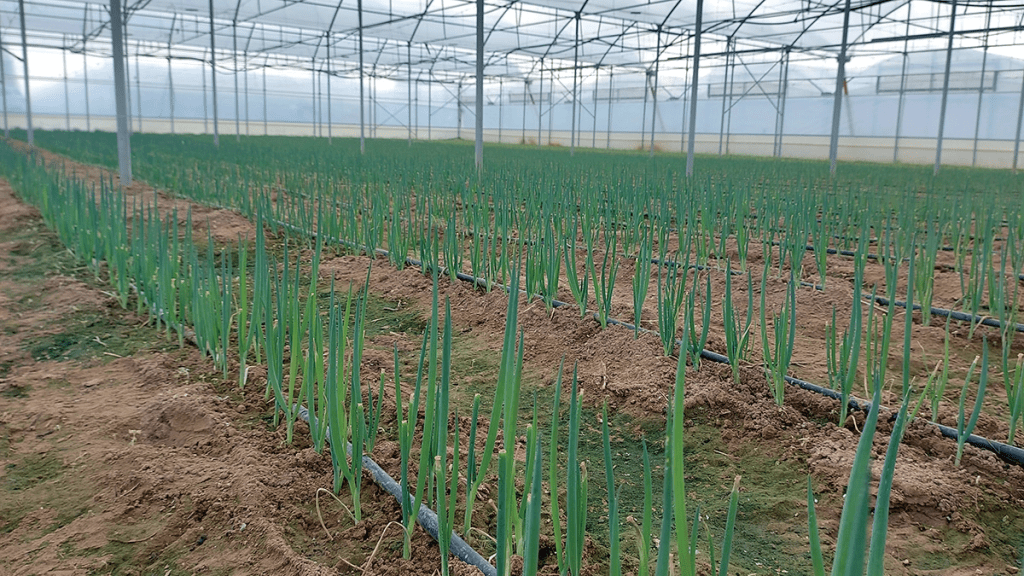Greenhouse onion farming in Kenya is gaining traction due to its ability to optimize growing conditions especially in arid and semi-arid regions that cover 80% of Kenyan land. Unlike open-field farming, greenhouses provide a controlled environment that regulates temperature, humidity, and pest exposure, ensuring healthier crops and higher yields. Onions, a staple in Kenyan households with an average daily consumption of 2-4 bulbs per household, are in constant demand making greenhouse farming a smart investment. Onion Doctor supports farmers with a comprehensive suite of services, including drought tolerant onion seedlings, drip irrigation systems, soil testing and agronomic support. Their mission is to transform underutilized arid land into productive onion and garlic hubs, boosting crop yields by up to 30% and tripling farmers incomes.
BENEFITS OF GREENHOUSE ONION FARMING
- Climate Control: Greenhouse maintain ideal temperatures for onion growth crucial in hot regions like Ukambani and the Coast.
- Water Efficiency: Drip irrigation, recommended by Onion Doctor, conserves water and ensures precise moisture delivery, critical for bulb formation.
- Pest and Disease Management: Greenhouse recommended by Onion Doctor, conserves water and ensures precise moisture delivery, critical for bulb formation.
- Year-Round Production: Unlike open-field farming, greenhouses allow farmers to produce onions during off-seasons, fetching higher prices.
- Crop Rotation: While greenhouse onion farming may not always be the most economically profitable option, it plays a crucial role in crop rotation by enhancing soil health and disrupting pest and disease cycles.

GUIDE TO GREENHOUSE ONION FARMING IN KENYA
- Site selection and Greenhouse setup: Choose a site with access to direct sunlight and well-drained, loamy soil with a pH of 5.8-6.8. Onion Doctor offers farm planning services to assess soil health. Establish a greenhouse.
- Seed Selection: Select high-yielding, disease- resistant varieties. Onion Doctor provides quality seedlings tailored for arid regions, ensuring robust germination and growth.
- Nursery Preparation: Prepare a raised nursery bed(1m wide) with well decomposed manure and phosphatic fertilizer. Sow seeds in shallow furrows 15cm apart mixed with sand or ash for even distribution, and cover with mulch. Irrigate daily for the first 10 days. Seedlings are ready for transplanting after 4-6 weeks when they reach 15 cm.
- Transplant: Transplant seedlings in the greenhouse during early morning or evening to avoid heat stress. Space them, use drip irrigation to maintain consistent moisture, avoid overhead watering to prevent fungal diseases. Onion Doctor`s drip irrigation systems ensure efficient water use.
- Crop Management: Apply nitrogen-rich fertilizers 4 weeks after transplanting. Use appropriate chemicals to control pests. Rotate crops and use fungicides to manage fungal diseases. Weed to avoid competition of nutrients.
- Harvesting and Storage: Harvest bulb onions after 100-120 days when the tops fall over and a flower stalk emerges. For immediate use gently pull onions; for storage, expose bulbs by pulling back soil and cure them in a dry, well ventilated area.

CHALLENGES FACING GREENHOUSE ONION FARMING IN KENYA
- High Initial and Operational Costs: Establishing a greenhouse requires significant capital investment for construction, irrigation systems, quality seeds, and other inputs. Ongoing operational costs, such as energy, water, and labor, further strain resources, especially for small-scale farmers.
- Pest and Disease Management: The enclosed environment of greenhouses can create favorable conditions for pests like thrips and diseases such as downy mildew and fusarium wilt. These issues can spread rapidly if not properly managed.
- Water Scarcity and Management: Despite the controlled environment, greenhouse farming still requires a reliable water supply. Inadequate water sources and poor irrigation practices can lead to water stress or waterlogging, affecting onion growth.
- Limited Technical Knowledge: Many farmers lack the necessary training in greenhouse management, including climate control, pest management, and crop nutrition, leading to suboptimal yields.
- Market Access and Price Volatility: Fluctuating market prices and limited access to reliable markets can result in reduced profitability, discouraging investment in greenhouse farming.
SOLUTIONS TO THESE CHALLENGES
- Financial Support and Cooperative Models: Farmers can form cooperatives to pool resources, access bulk purchasing discounts, and improve bargaining power. Additionally, seeking microloans or government grants can alleviate financial burdens.
- Integrated Pest Management (IPM): Implementing IPM practices, such as using resistant onion varieties, biological controls, and regular monitoring, can effectively manage pests and diseases while reducing chemical use.
- Efficient Water Use Strategies: Adopting drip irrigation systems and rainwater harvesting can ensure consistent water supply and reduce wastage. Proper drainage systems also prevent waterlogging.
- Capacity Building and Training: Participating in agricultural training programs and workshops can enhance farmers’ knowledge in greenhouse management, leading to improved practices and yields.
- Market Diversification and Value Addition: Exploring alternative markets, such as direct sales to consumers or processing onions into value-added products, can mitigate the effects of price volatility and expand income streams.
Onion Doctor has the best tips for greenhouse onion farming in Kenya Contact us for: Onion seedlings, Garlic seedlings, Germinated garlic cloves, Farm planning services, Soil testing, training on onion and garlic growing, Drip irrigation installation and maintenance, Agronomic support, Onion and Garlic value pack and Farm management. For free consultation, placing orders or booking a visit with an agronomist, please contact us via Call or what’s app +254703982228, Email: Info@oniondoctor.co.ke. You can also check out our social media handles for daily updates on TikTok: https://www.tiktok.com/@oniondoctorke?_t=ZM-8wmsTu0qumO&_r=1 Instagram: https://www.instagram.com/oniondoctorke?igsh=MTVoaHF3aWUydTJzaQ==Facebook:https://www.facebook.com/share/16SwgYn2dG/ Youtube:https://youtube.com/@oniondoctorke?si=u5Jnd-r0qU9UDYqL and Twitter: https://x.com/OnionDoctorKe?t=FR3JXlS_oN1vjjUgAtfyzg&s=09